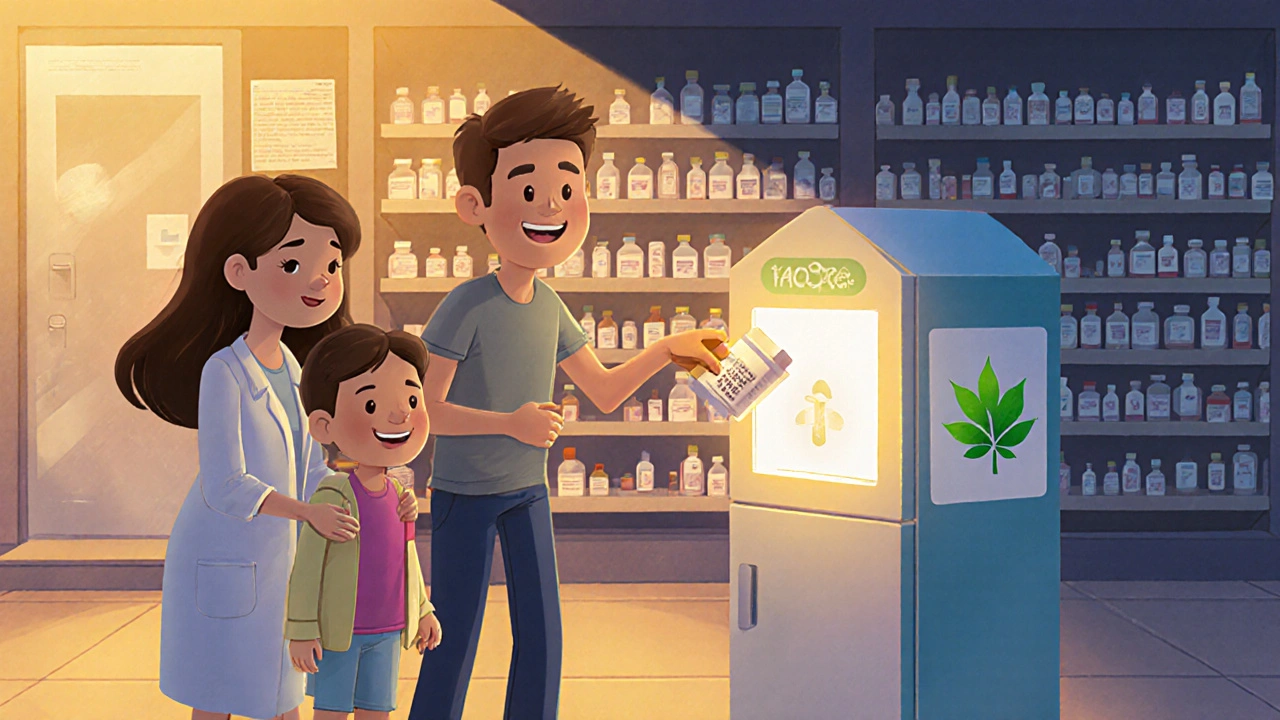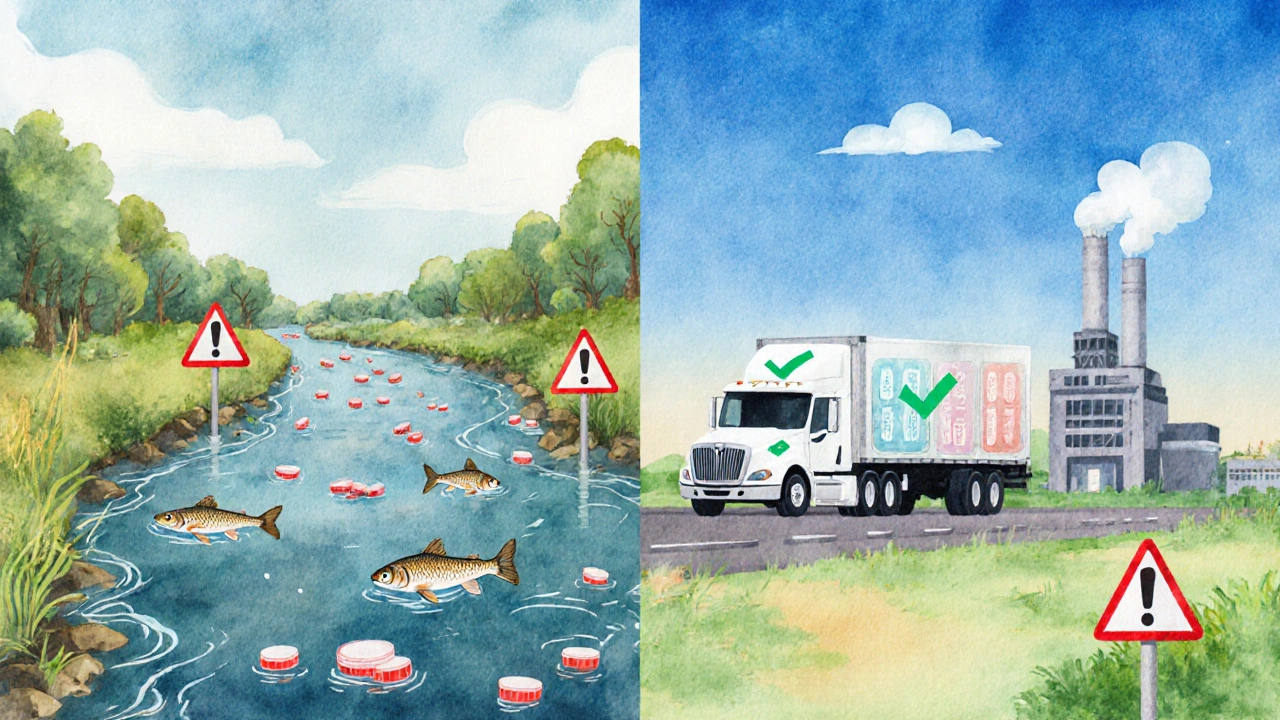
Every year, millions of unused or expired medications sit in bathroom cabinets, kitchen drawers, and medicine chests across the country. Many people don’t know what to do with them-so they flush them, toss them in the trash, or just leave them there. But these habits aren’t just sloppy-they’re dangerous. Flushing pills can poison water supplies. Leaving them lying around invites kids, teens, or pets to accidentally-or intentionally-take them. And in the U.S., over 100,000 people die each year from drug overdoses, many from medications they didn’t even get from their own prescriptions.
The solution isn’t complicated: drug take-back programs. These are free, safe, and legal ways to drop off old or unwanted medicines so they’re destroyed properly, without harming the environment or public health. But how do they actually work? Where can you find them? And what can you bring?
Drug take-back programs are run by federal, state, and local agencies-often in partnership with pharmacies, hospitals, and police departments. They exist because of the Secure and Responsible Drug Disposal Act of 2010, which gave the Drug Enforcement Administration (DEA) the power to set up permanent collection sites and organize nationwide events. Since then, over 19.8 million pounds of medications have been collected and safely destroyed.
There are three main ways these programs operate:
Whichever method you use, the medications are collected and taken to specialized facilities where they’re incinerated under strict environmental controls. This prevents them from ending up in landfills, rivers, or sewage systems-where they can harm wildlife and contaminate drinking water.
Not all medicines are accepted, and it’s important to know the rules before you go. Here’s what you can safely bring to most take-back locations:
But there are important exceptions. Do not bring these items:
Even if your local drop box says it accepts “all medications,” stick to the list above. If you’re unsure, call ahead. Many pharmacies will tell you exactly what they accept.
You don’t need to empty pills out of their bottles. In fact, it’s better if you don’t.
Here’s the simple step-by-step:
That’s it. No need to crush pills, dissolve them, or mix them with coffee grounds unless you’re using the FDA’s at-home disposal method-which should only be used if no take-back option is available.
There are more than 16,500 permanent collection sites across the U.S. right now. The easiest way to find one is to use the DEA’s official Drug Take Back Locator. Just enter your zip code, and it shows you nearby pharmacies, hospitals, and police stations with drop boxes.
Some of the most common locations include:
If you live in a rural area, options may be limited. Only 63% of rural communities have access to take-back programs, compared to 89% of urban ones. In those cases, mail-back programs are often the best alternative. Some states, like California and Oregon, provide free mailers through public health departments. Ask your pharmacist or local health office if one is available.

While the DEA’s twice-yearly take-back days get the headlines, they’re not the most effective solution.
Studies show that communities with permanent drop boxes have 25% higher participation rates than those relying only on one-day events. Why? Convenience. People forget about events. They don’t plan ahead. But if there’s a box right next to the pharmacy where they pick up their prescriptions, they’re far more likely to use it.
Another big factor: fear. When police officers staff drop-off locations, some people-especially those with past legal issues or distrust of law enforcement-avoid participating. A 2022 study found participation dropped 32% in areas where police were the only hosts. Pharmacies, on the other hand, saw a 41% increase in usage when they offered drop boxes. That’s because people feel safer and more comfortable in a healthcare setting.
Some communities are even using mobile units. Broward County, Florida, runs a program called Operation Medicine Cabinet that drives a van to libraries, senior centers, and community events. They’ve seen 73% higher participation than fixed locations.
Once collected, the medications are transported in locked, tracked vehicles to licensed medical waste facilities. There, they’re destroyed using high-temperature incineration-similar to how hospitals dispose of biohazard waste.
This method is the only one approved by the EPA and FDA because it ensures zero chance of the drugs re-entering the environment. Landfilling or flushing doesn’t work. Medications can leach into groundwater. Even composting or burying them isn’t safe.
Incineration also prevents diversion. Every year, thousands of teens get access to painkillers or ADHD meds by raiding their parents’ medicine cabinets. Taking those pills out of circulation reduces the risk of misuse before it even starts.
Drug take-back programs aren’t just about cleaning out your medicine cabinet. They’re a critical tool in fighting the opioid crisis.
Dr. Rahul Gupta, former Director of the Office of National Drug Control Policy, called these programs “one primary prevention method to reduce the supply of diverted prescription drugs.” And the data backs it up. Communities with strong take-back programs have seen a 19% drop in prescription drug misuse among teenagers within three years.
It’s also a public safety issue. In 2023, over 2,000 children under age six were treated in emergency rooms after accidentally swallowing medications they found at home. Most of those cases involved pills left unsecured.
And environmentally? The EPA says flushing medications is one of the top sources of pharmaceutical pollution in U.S. waterways. Fish, frogs, and even drinking water have been found with traces of antidepressants, birth control, and antibiotics. Take-back programs stop that before it starts.

If you live in a rural area or can’t get to a drop box, the FDA has a backup plan-but it’s not ideal.
Here’s what to do if you absolutely have no other choice:
Never flush unless the FDA specifically lists the drug as safe to flush. There are only about 15 medications on that list-mostly powerful opioids like fentanyl patches that could be deadly if found by a child. For everything else, don’t flush. Ever.
Things are getting better. Since 2021, the DEA has pushed the message: “Every Day is Take Back Day.” That’s why the number of permanent sites has jumped from 5,000 in 2020 to over 16,500 today.
There’s also new legislation on the table. H.R. 4278, introduced in 2023, would require Medicare Part D plans to cover the cost of mail-back envelopes for seniors. That could help 48 million older Americans dispose of meds safely without leaving home.
But challenges remain. Over half of local programs say funding is their biggest problem. Running a drop box costs around $18,500 a year. Many rely on grants or donations. Pharmacists still report confusion about DEA rules-68% say they’re unsure what they’re allowed to accept.
Still, progress is real. And it’s growing. The more people use these programs, the more communities will invest in them.
You don’t need to wait for a national event. You don’t need to drive across town. Here’s your action plan:
One person dropping off a few bottles won’t solve the crisis. But if millions of people did it? That’s how change happens.
15 Responses
Just dropped off my dad’s old painkillers at the Walgreens down the street. Took 2 minutes. No questions asked. 🙌
Wow, this is brilliant! I mean, truly, it's a small act, but it's one that ripples-through ecosystems, through households, through generations. We must do better, and this is a step, a real, tangible step, towards responsibility!
Let’s be real-most people who use these programs are middle-class folks with access to pharmacies. Meanwhile, low-income families still flush meds because they can’t drive 20 miles to a drop box. This isn’t a solution-it’s a PR campaign with a box.
Actually, you should know that the DEA doesn’t even handle the incineration-they just oversee it. The actual disposal is contracted out to private waste companies, and some of them still dump in landfills under loopholes. I’ve got the audit reports if you want to see them.
Just did this today! 📦💊 Took my expired antidepressants and some leftover oxycodone from last year’s surgery. Walgreens made it easy. I even brought my cousin’s meds too. We need more of this. Not just for safety-for dignity.
Thank you for sharing this. It's so important to think about the safety of our children and the health of our environment. I've started keeping a small bin in my bathroom for expired meds. Small habits make big changes. You're doing great!
Why are we letting the government tell us how to dispose of our own medicine? This is just another step toward control. If I want to flush my pills, I’ll flush my pills. I pay taxes-I deserve to make my own choices.
It is noteworthy that the prevalence of permanent collection sites exhibits a statistically significant correlation with urban population density. Rural communities remain underserved, and this disparity constitutes a public health inequity of considerable magnitude
THIS IS THE KIND OF SH*T THAT SAVES LIVES. I used to hoard my old prescriptions like they were heirlooms. Then my cousin OD’d on pills she found in her uncle’s cabinet. Don’t be that guy. Drop. It. Off. Right. Now. 🚨
Excellent and thorough overview. I’ve been using the mail-back service in the UK for years-simple, secure, and environmentally sound. It’s a shame more countries don’t make it universally available. This deserves wider adoption.
why do we even have these programs? in india we just throw it in the trash or give it to the local chemist. no one cares. why is america so obsessed with rules and boxes? its overkill
There is no evidence that these programs significantly reduce overdose rates. The correlation is coincidental. The real issue is mental health care access.
My grandma’s cabinet was a pharmacy. I cleaned it out last week. Took two bags. No drama. Just did it. You don’t need a ceremony. Just a box and a second.
just went to the police station dropbox. they had a sign that said ‘no needles’ so i asked if they took insulin pens. guy said yeah as long as the needle’s off. easy peasy. thanks for the heads up on the pill bottles too
Another feel-good distraction. You think this stops the opioid crisis? Wake up. The real problem is pharma greed and doctors overprescribing. This is just virtue signaling with a locked box.